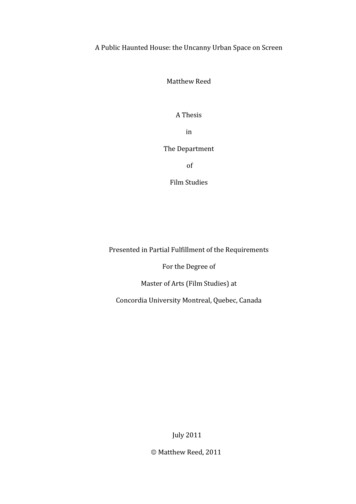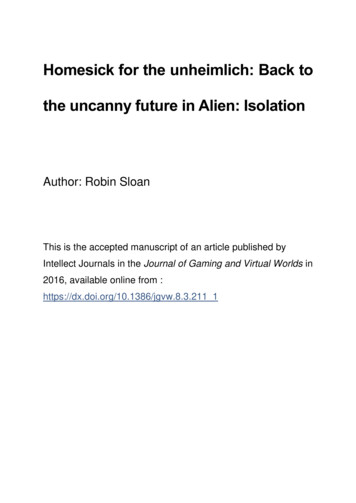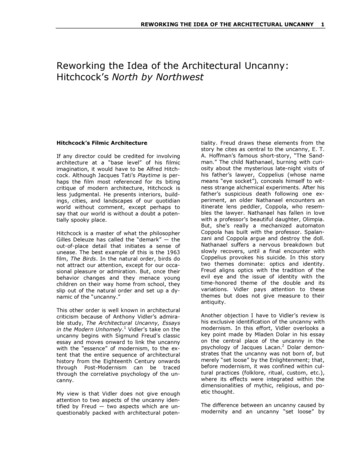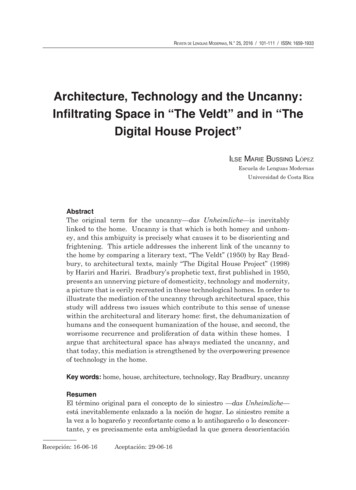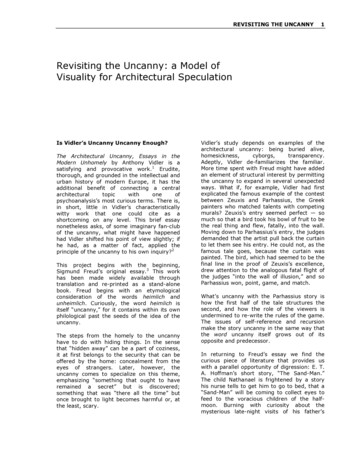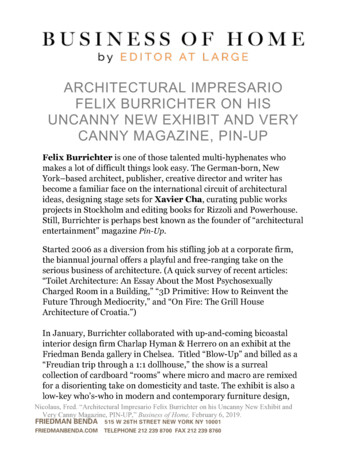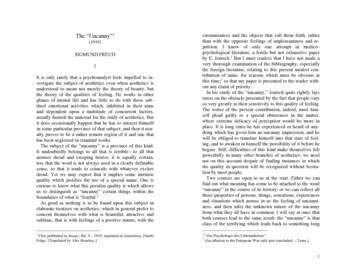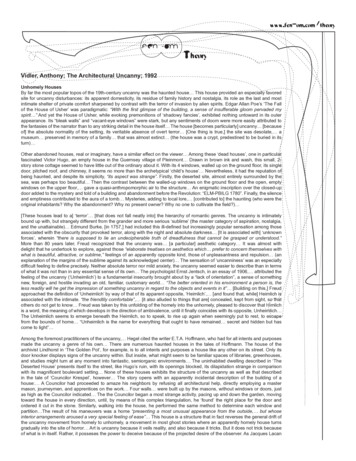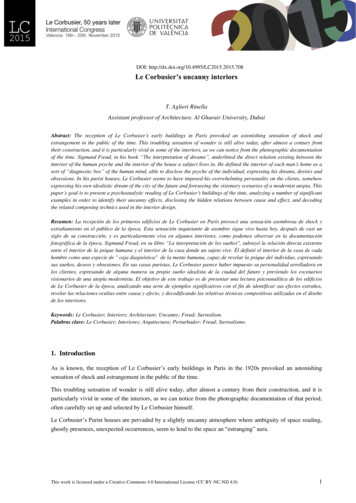
Transcription
DOI: http://dx.doi.org/10.4995/LC2015.2015.708Le Corbusier’s uncanny interiorsT. Aglieri RinellaAssistant professor of Architecture. Al Ghurair University, DubaiAbstract: The reception of Le Corbusier’s early buildings in Paris provoked an astonishing sensation of shock andestrangement in the public of the time. This troubling sensation of wonder is still alive today, after almost a century fromtheir construction, and it is particularly vivid in some of the interiors, as we can notice from the photographic documentationof the time. Sigmund Freud, in his book “The interpretation of dreams”, underlined the direct relation existing between theinterior of the human psyche and the interior of the house a subject lives in. He defined the interior of each man’s home as asort of “diagnostic box” of the human mind, able to disclose the psyche of the individual, expressing his dreams, desires andobsessions. In his purist houses, Le Corbusier seems to have imposed his overwhelming personality on the clients, somehowexpressing his own idealistic dream of the city of the future and foreseeing the visionary scenarios of a modernist utopia. Thispaper’s goal is to present a psychoanalytic reading of Le Corbusier’s buildings of the time, analyzing a number of significantexamples in order to identify their uncanny effects, disclosing the hidden relations between cause and effect, and decodingthe related composing technics used in the interior design.Resumen: La recepción de los primeros edificios de Le Corbusier en París provocó una sensación asombrosa de shock yextrañamiento en el público de la época. Esta sensación inquietante de asombro sigue vivo hasta hoy, después de casi unsiglo de su construcción, y es particularmente viva en algunos interiores, como podemos observar en la documentaciónfotográfica de la época. Sigmund Freud, en su libro “La interpretación de los sueños", subrayó la relación directa existenteentre el interior de la psique humana y el interior de la casa donde un sujeto vive. Él definió el interior de la casa de cadahombre como una especie de " caja diagnóstica" de la mente humana, capaz de revelar la psique del individuo, expresandosus sueños, deseos y obsesiones. En sus casas puristas, Le Corbusier parece haber impuesto su personalidad arrolladora enlos clientes, expresando de alguna manera su propio sueño idealista de la ciudad del futuro y previendo los escenariosvisionarios de una utopía modernista. El objetivo de este trabajo es de presentar una lectura psicoanalítica de los edificiosde Le Corbusier de la época, analizando una serie de ejemplos significativos con el fin de identificar sus efectos extraños,revelar las relaciones ocultas entre causa y efecto, y decodificando las relativas técnicas compositivas utilizadas en el diseñode los interiores.Keywords: Le Corbusier; Interiors; Architecture; Uncanny; Freud; Surrealism.Palabras clave: Le Corbusier; Interiores; Arquitectura; Perturbador; Freud; Surrealismo.1. IntroductionAs is known, the reception of Le Corbusier’s early buildings in Paris in the 1920s provoked an astonishingsensation of shock and estrangement in the public of the time.This troubling sensation of wonder is still alive today, after almost a century from their construction, and it isparticularly vivid in some of the interiors, as we can notice from the photographic documentation of that period,often carefully set up and selected by Le Corbusier himself.Le Corbusier’s Purist houses are pervaded by a slightly uncanny atmosphere where ambiguity of space reading,ghostly presences, unexpected occurrences, seem to lend to the space an “estranging” aura.This work is licensed under a Creative Commons 4.0 International License (CC BY-NC-ND 4.0)1
Regarding the interiors of the La Roche house, Tim Benton has spoken of “Unheimlich” («Uncanny» inEnglish), claiming that the arcane sensation perceptible along its “architectural promenade” may be put inrelation with the theories of K.A. Scherner and Sigmund Freud and explaining the psych-sensorial origin of thesefeelings with a comparison between oneiric sensations and the sensorial experience of the “promenade”1.According to Scherner, the oneiric fantasy had as a favorite symbolic representation the image of a house.Sigmund Freud, in his book “The interpretation of dreams”, underlined the direct relation existing between theinterior of the human psyche and the interior of the house that a person lives in. He defined the interior of eachman’s home as a sort of “diagnostic box” of the human mind, able to disclose the psyche of the individual,expressing his dreams, desires and obsessions2.The concept of Unheimlich was described by Freud in a famous essay3. The term Unheimlich is the contrary ofHeimlich4, which means familiar, homely (the root heim means “home”). Unheimlich is therefore what, even ifreferring to a domestic environment, is not totally familiar to us, because we grasp something different andunusual that surprises and creates a sensation of “estrangement”.In other words, we feel the Unheimlich in architecture when we grasp something of anomalous, ofunconventional, which more or less unconsciously strikes our feelings, in an interior domestic space which weshould be accustomed to. It is the sudden revelation of these unexpected concealed elements, latent presences inour subconscious, which make us feel the vibrant Unheimlich sensation.In architectural design, illusionistic expedients of any kind, decontextualizations, allusions, abrupt changes ofarchitectural scale and dimensions, unexpected presences, mysterious solutions and surprise-effects, are allemotional devices able to immerge space users into an estranging and oneiric atmosphere.Anthony Vidler, in his book The Architectural Uncanny5, has deeply investigated the concept of Unheimlich inarchitecture. Even if frequently associated with the frightening feelings of fear and mystery, according to FreudUnheimlich doesn’t necessarily have a negative meaning. Unheimlich can be just something of new andunknown, and often what is new is scaring for most people. This may also partially explain the sense of shock(or even of refusal) often produced by Le Corbusier’s early buildings in the Twenties.In his purist houses, Le Corbusier imposed his overwhelming personality on the clients, somehow expressing hisown ideal dream of the city of the future and foreseeing the visionary scenarios of a modernist utopia.One can assume that the complex client-architect relation in many Le Corbusier’s projects could be similar to asort of psychoanalytic ‘positive’ transfert, in which the client unconsciously assign to the architect “passion”feelings in a way very similar to a process of “love” attraction. This is particularly relevant in residentialprojects, where the architect is appointed to design his client’s “home” (so, according to Freud his “diagnosticbox”). In these cases, the architect has to deep-dig into the clients’ psyche, understanding and analyzing their1Benton Tim, “Villa La Rocca, Die Planungs und Baugeschichte Der Villa La Roche”, in Ein Haus für den Kubismus, DieSammlung Raoul La Roche. Basel: Kunstmuseum, 1998, pp. 227-243.2Freud Sigmund, Die Traumdeutung, 1899. Italian ed.: L'interpretazione dei sogni. Turin: Bollati Boringhieri, 1973.3Freud Sigmund, Das Unheimliche, 1919. Italian ed.: “Il perturbante” in Saggi sull’arte la letteratura e il linguaggio. Turin:Bollati Boringhieri, 1969.4In German, a further meaning of the term Heimlich is also «secret, hidden», that could seem antithetical to the concept of«familiar» and «homely». Heimlich therefore presents a sort of ambiguity, in which the less used meaning (mysterious,hidden) is almost coincident with its opposite Unheimlich.5Vidler Anthony, The Architectural Uncanny: Essays in the Modern Unhomely. Cambridge (Mass.)-London: The MIT Press,1992.This work is licensed under a Creative Commons 4.0 International License (CC BY-NC-ND 4.0)2
conscious and subconscious needs and desires, elaborating and mediating them through the architect’s leadingpersonality.For Le Corbusier, this can be certainly true in some cases, such as for the project of Raoul La Roche’s house,where the client, a banker and art collector, was totally fascinated by his architect’s aesthetic sense andpersonality. The client completely agreed on his ideas, giving him maximum freedom in his house’s design.This relation of total reliance between client and architect is quite rare. La Roche was a bachelor who livedalone. His only passion was contemporary art, into which his great friend Le Corbusier had initiated him. Theproject of his house was intended to “frame” his collection of paintings, including those of Le Corbusier himself(significantly hanged in the more private space of the bedroom). Their friendship lasted a whole lifetime alwayswith equal strength. According to Freud’s theories, one may assume that La Roche lived towards Le Corbusier akind of ‘positive’ transfer, similar to a proper “love” attraction.On the contrary, this is certainly not the case of the project for the eccentric millionaire Charles De Beistegui,where the kind of relation with the architect was more similar to a brief “infatuation” (with subsequent quickseparation and psychological removal). Here the project was the result of a “match” between two overwhelmingpersonalities, both with strong (even if different) views and ideas, which outcome was an extraordinary crossingof unexpected reciprocal affinities.Considering the psychoanalytic implications, Tim Benton attempted to uncover both the stimuli, or “elements”of Le Corbusier’s designs, and the process whereby the design components are transformed and distorted into apoetic architectural language6. A number of authors presented introspective analyses of some of Le Corbusier’sbuildings, revealing the presence of significant stimulating aspects related to horror vacui, symbolism, mnesticassociations, voyeurism, transparency and “surrealist” illusionism.All these features are evident in a lot of significant buildings, from the pre-Parisian villa Turque to thesubsequent La Roche house, villas Church, Stein and Savoye, up to Charles de Beistegui’s apartment.In the present brief essay, I will attempt to present a psychoanalytic reading of some of Le Corbusier’s mostrelevant buildings of the time, analyzing a number of significant examples in order to identify their uncannyeffects, disclosing the hidden relations between cause and effect, and decoding the related composing technicsused in the interior design.2. Horror Vacui, Sublime and oneiric sequencesHorror Vacui literally means from its Latin origins «fear of empty space». In architecture, we feel this disturbingsensation when entering into a very large and empty space, coming from a smaller sized room. This is a peculiarrecurrent characteristic of the architectural “Uncanny”. Walter Benjamin7 observed that the Uncanny wasgenerated by the appearance of modern large towns, with their huge empty spaces and the heterogeneous crowdsflowing the Parisian boulevards. This originated the individual’s alienation as a modern collective pathology.The metropolitan Uncanny is often expressed by phobias associated to the space’s experience, such asagoraphobia, fear of large open spaces and of the void, which we find with different scales and characteristics inmany of Le Corbusier’s interiors, where the sudden occurrence of wide empty spaces is a recurrent feature.6Tim Benton mentions the drawings used by Le Corbusier to illustrate his lectures in Argentina, where these processes oftransformation of physical stimuli are described in terms of “digestion”. Cf. Benton Tim, Villa La Rocca, op.cit.7Benjamin Walter, “Uber einige Motive bei Baudelaire”, in Gesammelte Schriften, vol. I. Frankfurt am Main: 1974. Italianed.: “Di alcuni motivi in Baudelaire”, in Angelus novus. Saggi e Frammenti, Einaudi. Turin: Einaudi, 1962, pp. 109-130.This work is licensed under a Creative Commons 4.0 International License (CC BY-NC-ND 4.0)3
Galleries, overhead walkaways and balconies abruptly open to the void, generating a dizziness feeling thatcharges the environment with emotional tension.The Uncanny has been also related to the more magnificent concept of Sublime8, even keeping significantdifferences. Edmund Burke assumed that one of the main causes of Sublime was terror (e.g. of the void, of thegreat dimension of the nature). In certain cases and contexts, Sublime and Uncanny can appear indistinguishableand similar. Shock is an estranging tool of contemporary art, and Freud himself acknowledged the Uncanny asan aesthetic category, existing within the traditional limits of Sublime, or rather in «all that generates anguish andterror»9. The Uncanny, however, can’t be just considered as an expression of negative sensations, but as a varietyof forms and aspects, able to provoke estrangement also as a consequence of positive emotions.In Le Corbusier’s architecture, the plan libre allowed by reinforced concrete structure creates fluid inner spaceinterpenetrations through mezzanines, internal courtyards and double high spaces in a continuous sequencedeveloped along the promenade. In Notes à la suite10 he defined these interpenetrations as the “enjambements”of modern architecture, particularly present in the hall of the La Roche house, where the promenade is a dreamlike path full of emotional tensions, leading the visitor through a succession of spaces, ramps, stairs, bridges andmezzanines open over the void. Tim Benton also compared the feelings provoked by this dramatic path to aSublime sensation evoking a Piranesian scenario, imagining La Roche walking alone at night to reach hisbedroom11.Since the entrance to the La Roche house, after an external approaching path, the visitor is obliged to passthrough a narrow access door, a simple opening cut in a recessed wall located in the corner between two wingsof the building. This entrance seems conceived
5 Vidler Anthony, The Architectural Uncanny: Essays in the Modern Unhomely. Cambridge (Mass.)-London: The MIT Press, 1992. This work is licensed under a Creative Commons 4.0 International License (CC BY-NC-ND 4.0) 3 conscious and subconscious needs and desires, elaborating and mediating them through the architects leading personality. For Le Corbusier, this can be certainly true in some cases .

![Le Corbusier Expo [Modo de compatibilidad]](/img/5/2014-06-09-11-39-00104710.jpg)
